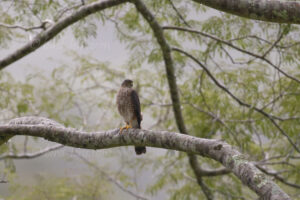 One afternoon we almost finished our hike through the forest of Refugio Los Volcanes in Santa Cruz province in south-eastern Bolivia. Already almost back to the accomodation, we spotted a female Rufous-thighed Hawk (Accipiter erythronemius) – a close relative to the Eurasian Sparrowhawk (Accipiter nisus), an ecological counterpart, in structure and plumage, and, to a lesser extent, the Rufous-breasted Sparrowhawk (Accipiter rufiventris) of East and South Africa and – of course the Sharp-shinned Hawk (Accipiter striatus) is a birdwatcher’s delight, it is a rare and exhilarating experience. This elusive raptor, with its striking rufous thighs and agile flight, often remains hidden in the dense canopies of South American forests. Discovering one requires patience, keen observation, and a bit of luck – as we had at that time. The moment we glimpse it perched silently, a sense of wonder and accomplishment washes over you.
One afternoon we almost finished our hike through the forest of Refugio Los Volcanes in Santa Cruz province in south-eastern Bolivia. Already almost back to the accomodation, we spotted a female Rufous-thighed Hawk (Accipiter erythronemius) – a close relative to the Eurasian Sparrowhawk (Accipiter nisus), an ecological counterpart, in structure and plumage, and, to a lesser extent, the Rufous-breasted Sparrowhawk (Accipiter rufiventris) of East and South Africa and – of course the Sharp-shinned Hawk (Accipiter striatus) is a birdwatcher’s delight, it is a rare and exhilarating experience. This elusive raptor, with its striking rufous thighs and agile flight, often remains hidden in the dense canopies of South American forests. Discovering one requires patience, keen observation, and a bit of luck – as we had at that time. The moment we glimpse it perched silently, a sense of wonder and accomplishment washes over you.
Nestled within the diverse landscapes of Bolivia, the Rufous-thighed Hawk stands as a striking example of the region’s avian splendor. This medium-sized raptor, characterized by its reddish-brown thighs and barred underparts, thrives in the subtropical and tropical forests of Bolivia, as well as in open woodland and even urban areas.
The Rufous-thighed Hawk is a member of the Accipitridae family, a group that encompasses some of the most formidable birds of prey. These hawks are adept hunters, relying on their keen eyesight and swift flight to catch small birds and mammals. Their plumage, which provides effective camouflage among the dense foliage, aids them in silently stalking their prey before a sudden, lethal strike.
In Bolivia, the Rufous-thighed Hawk shares its habitat with several notable relatives. Among these is the Roadside Hawk (Rupornis magnirostris), a versatile and common bird of prey found across a wide range of elevations. Distinguished by its yellow legs and finely barred tail, the Roadside Hawk adapts well to human-altered landscapes, often seen perched along roadsides – a trait that lends it its name. This adaptability highlights the resilience and resourcefulness characteristic of many hawk species.
Another remarkable relative is the Bicolored Hawk (Accipiter bicolor), which inhabits similar regions. This raptor, slightly larger than the Rufous-thighed Hawk, exhibits a sharp contrast in plumage between its dark upperparts and white underparts. Known for its aggressive hunting style, the Bicolored Hawk often preys on birds in mid-flight, showcasing an aerial prowess that is truly captivating.
The striking Ornate Hawk-Eagle (Spizaetus ornatus), though less commonly encountered, also shares the Bolivian skies. Renowned for its elaborate crest and striking pattern of black, white, and rufous feathers, this bird epitomizes the beauty and power of raptors. Preferring dense forests, the Ornate Hawk-Eagle is a top predator in its ecosystem, hunting larger prey including monkeys and sloths.
These hawks and their relatives play a crucial role in maintaining the balance of their ecosystems. As apex predators, they help control the populations of smaller animals, ensuring a healthy and dynamic environment. Conservation efforts in Bolivia are vital to protect these majestic birds and their habitats from threats such as deforestation and habitat fragmentation.
Observing the Rufous-thighed Hawk and its relatives offers a window into the intricate web of life in Bolivia’s diverse ecosystems. Their presence underscores the rich biodiversity of the region and the importance of preserving these natural treasures for future generations.
In order to meet the growing demand for top images of the rarer species of Palaearctic Bird-lens.com has specifically made trips to remote places. Additionally every chance is used, if a rare bird is around the homeground. This to do everything to ensure excellent photos of the Birds of the Western Palearctic . The yield of pictures also of rare Western Palaearctic birds is very good. There are other nice images of birds, that you will find behind the tab “Picture Shop“. Just give a notice if you need a picture of a bird which is not online.